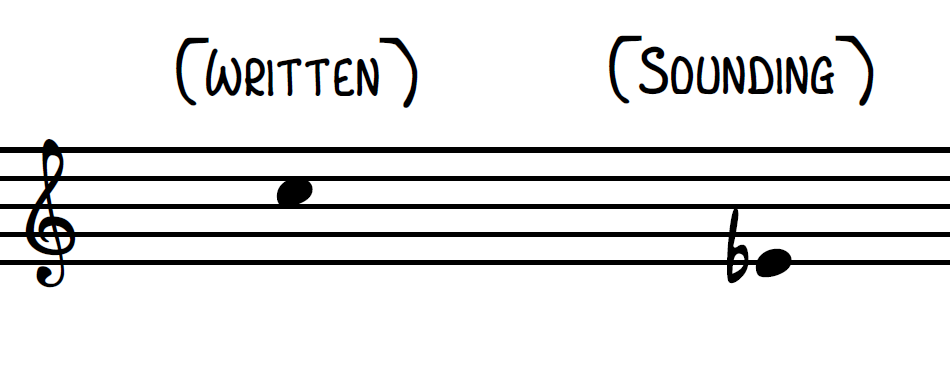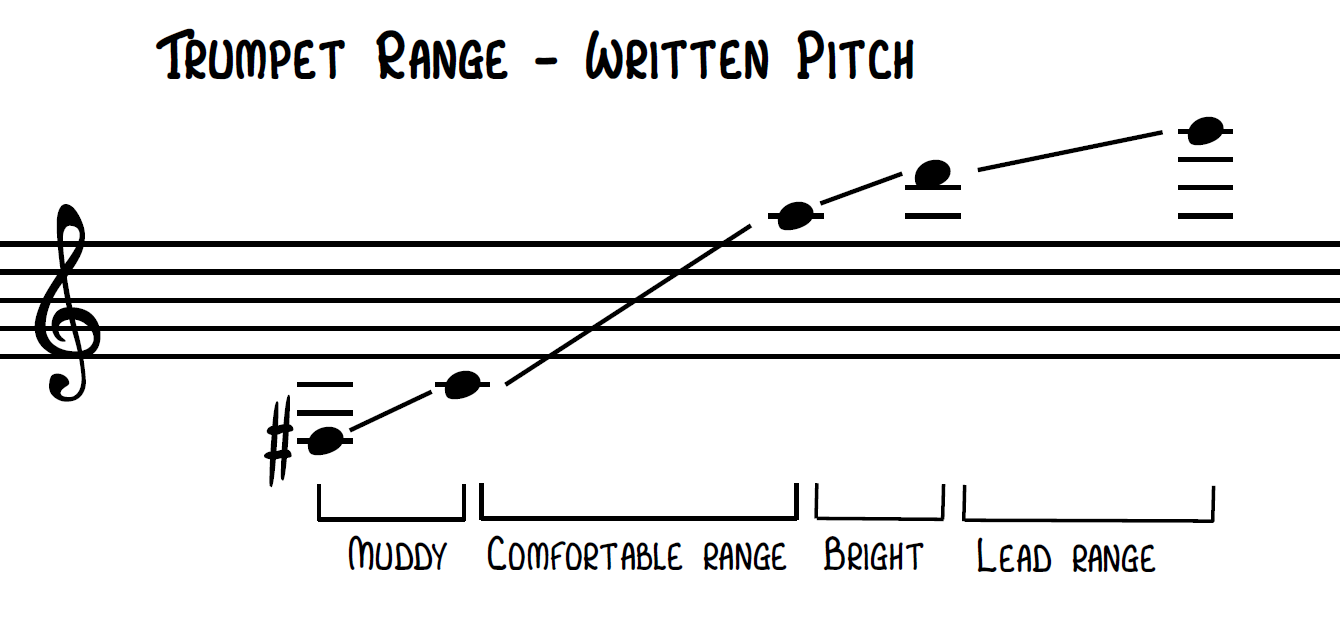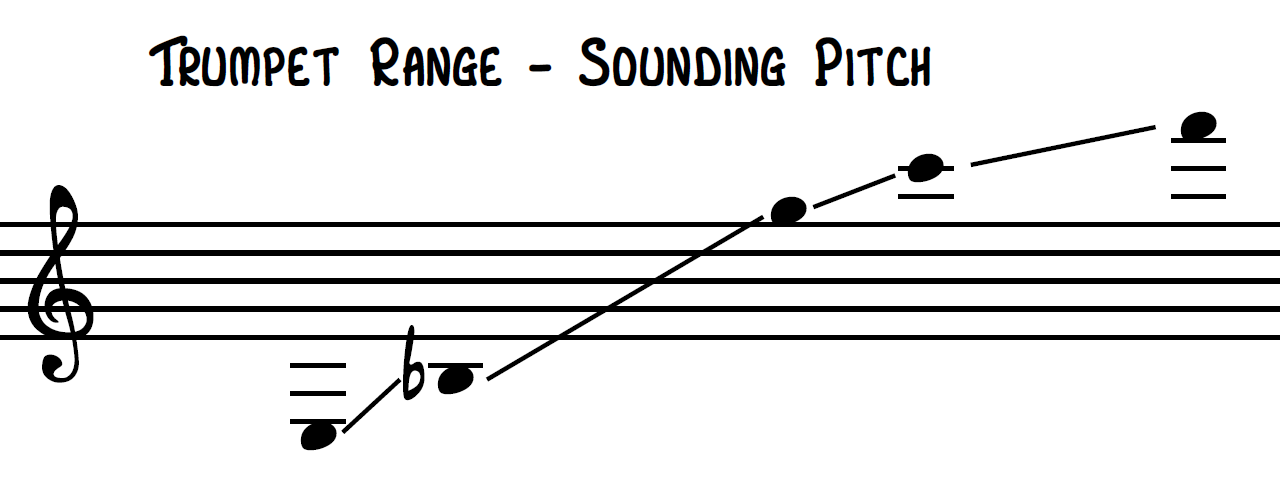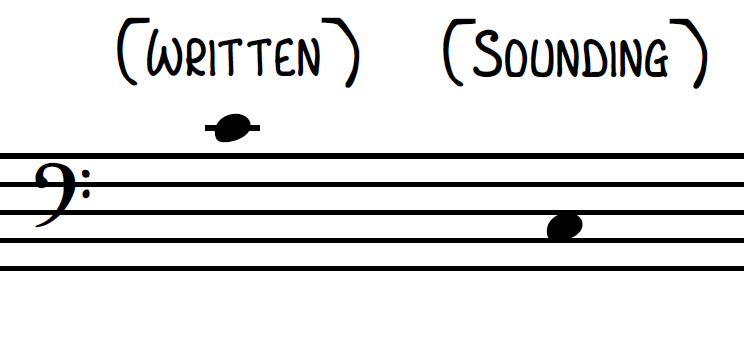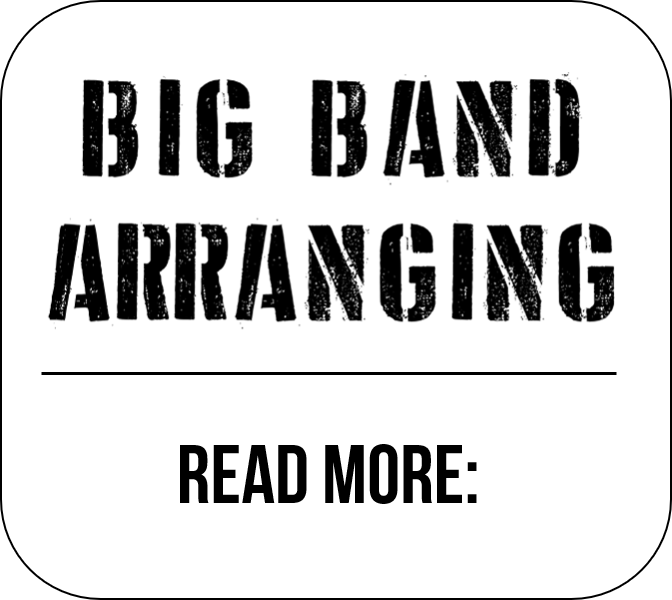3 | Instrumentation
RANGES & COLOUR
If you’re anything like me, instrument range charts kind of frustrate me. At worst they don’t seem to represent reality, or at best imply that each note feels exactly the same as every other note, like a piano. A low Bb on a sax versus it’s top F# is completely different in terms of intonation, dynamic, control and black and white dots on a stave don’t reflect this very accurately. I also enjoy the kind of pompous adjectives that get attributed to various parts of instrumental ranges like a sonic wine tasting. Does anyone actually see an oboe range in a textbook and then think ‘I need a buttery oboe sound here’ and proceed to only use the lower register? I prefer practical words like ‘difficult’ or ‘controllable’ to know how my writing will affect the player.
Range charts also seem to contradict what we hear. We hear crazy high trumpets screaming in big band charts all the time for instance, so then you go and check a trumpet range in a book and then you see a top C. But you heard the G higher than that. So you write a top G and some player tells you that’s too high. So you stop writing the top G and then another player on a gig plays your regular G up the octave and says ‘why didn’t you write that up the octave?’. Frustrating.
If you’re anything like me, I take ranges in books with a pinch of salt and then have to figure out what we can really use on the job. Assuming you’re working with good players or professionals, I’ve tried to create range charts that don’t require that pinch of salt.
It’s worth noting that the full range of the sax is easily accessed by even intermediate players (tuning it is another matter!), whereas brass instruments like trumpet and trombone take years to develop even a passable upper (and lower) register. If you’re working with half-way decent players, you can think of the range of the sax and rhythm section instruments a bit like the piano (to an extent) in that all the notes are laid out before you, you as the arranger just have to make sure they’re the right notes. The brass instruments you really have to know the capability of your players to give you your upper (and sometimes lower) ranges.
SAXES
Every saxophone has the same written range. The fingering system for all saxes is also the same. That means that once the written sax range is memorised, checking any big band score in transposed pitch should show how well it’s suited to the sax.
Here’s the range for every sax as the players would see it:
Different types of sax (alto, tenor etc.) also have very similar timbre and colour properties in different registers. The lower instruments, tenor and bari saxes, tend to be warmer and breathier than altos and sopranos of course, but you can generally think of the range of the saxophone as split into two sections:
The darker green shows where the sound is thickest:
Notice how the lowest notes, with the most keys pressed down are the thickest sounding. The register gets gradually thinner as less keys are used. The ‘break’ happens from written C# to D in the middle of the stave. Written C#, both on the stave and above are annoying notes. No keys are pressed down, so the resistance is very little and makes it hard to control the intonation and colour. Good players can of course hide this through a combination of embouchure and/or alternative fingerings and you won’t really notice much of a difference when a good player crosses from C# to D.
The altissimo register extends beyond high F# and only specialised professionals will have full control over it, which they might pull out in improvised solos. Writing any note in a big band arrangement above F# - even if you have a good altissimo player who could do it - never happens. (Contemporary classical sax music which pretty much lives in that register is another matter!)
The entire range of the sax is easy to access for even intermediate players. Unlike brass instruments, all notes are (relatively) readily available although intonation in the highest 5th or so of the range can be a bit troublesome, as can playing quietly in the lowest 3rd.
As a comparison for orchestrally-inclined composers and arrangers, when looking at any saxophone in written pitch, you’ll notice the range looks nearly the same as an oboe. Think of the saxes capabilities like an oboe too: Avoid the bottom few notes in quiet passages and be wary of intonation issues above the highest C. The fingering for these high and low notes is also slightly awkward, so while the sax is capable of playing blindingly fast, take care with these aspects of the range.
Saxes are all very agile and the break doesn’t prove much of a problem like in clarinets. All trills and most trems of a third are possible. They’re very forgiving to write for. If you want to write very conservatively, maybe for amateur or younger players, take a 4th off the top and bottom of the range and you’ll be safe in pretty much every situation at every dynamic. (But leave the low notes in for bari sax!)
ALTO SAX
Transposition
The alto sax is in Eb. The easiest way to score-read alto parts is:
From a transposed score - read down a major 6th
If you’re more familiar with orchestral score-reading, it’s like reading a French Horn part and adding an extra tone. There are other tricks you can do like swapping out the treble clef for a bass clef, removing 3 sharps from the key signature and reading down an octave, but that kind of thing is better reserved for the baritone sax (see below).
For a score in C, you can of course do this in reverse and read up a major 6th.
Range
Here’s the alto sax sounding range. When writing a score in C, keeping everything neatly on the stave and just a few ledger lines below is a good approach for alto saxes. If your part looks like it needs a bass clef to be read clearly it’s probably hanging just a bit too low:
TENOR SAX
Transposition
The tenor sax is in Bb. The easiest way to score-read these parts is:
From a transposed score - read down a major 9th.
Range
As mentioned before, the written tenor sax range is exactly the same as the alto and all other saxes. The sound is somewhat fuller and often more breathy than the alto, especially when lower.
The written C# to D break in the tenor sax sounds as B to C. This very convinient to rememember for both alto and tenor saxes when writing a score in C - the alto sax break is E to F and the tenor’s is B to C. These are the only semitones between white notes on the piano. As mentioned before, the break isn’t usually a problem, but fast passages repeating over it or tremolos should be checked for playability here:
BARI SAX
Transposition
The bari sax is in Eb and always uses the treble clef. The easiest way to score-read a bari sax part quickly from a transposed score is:
Put a bass clef in front of the note you want to read.
Then add 3 flats to the key signature.
This way of score-reading just feels like reading a different clef and is very quick to identify notes both from a concert and transposed score because they’ll be on the same space/line on the stave. If in doubt, check against the bassline and bass trombone part (both in C) which will usually be doing something harmonically compatible.
Range
The range for the bari is the same as the alto and tenor, but note the addition of a written low A. This is really useful, as it’s a commonly-used low C in concert pitch. It’s available to pros and some semi-pros with an extra key for the instrument.
The low register of the bari offers some resistance due the size of the instrument of course, but players specialise in reaching these low notes and writing in the bottom 5th is perfectly common, (and in fact encouraged), unlike other saxes.
Writing too high for bari makes balance and intonation an issue, as well as not being very idiomatic for the instrument. Altissimo is very rare. The bari has nearly the same technical facility of the alto and tenor and is capable of very incisive attacks.
All of the same technical considerations of the alto and tenor, apart from that of the low register, apply to the bari too.
TRUMPET
Transposition
The trumpet used in big bands is in Bb. You don’t need to specify this - you can just write ‘trumpet’. To score-read:
From a transposed score - read down a major 2nd.
Range
It takes many years for players to achieve a good sound in each part of any brass instrument’s range. Players, even at a very high level, will often specialise. Most pros will have a solid sound throughout though, regardless of which part they prefer to play.
This is the general range of the trumpet. The lowest register, unless you have a good 4th trumpet, is generally unfocussed. The fingerings in the lowest octave are somewhat limiting and fast passages should be written with some care, watching for awkward fingerings. Other than that, the technical facility throughout the trumpet is excellent.
You’ll notice the highest range of the trumpet (the lead range) is higher than orchestral music. How high a player can reach is an individual thing. It’s common practice as an arranger to change your upper-ranges for each trumpet based on their role. 2nd Trumpet wouldn’t play as high as the Lead, 3rd wouldn’t play as high as 2nd etc. We’ll cover this exact topic in detail below.
With all that in mind, writing in the ‘lead range’ should be avoided apart from for the lead trumpet in a good big band. If in doubt - keeping things on the stave will usually get good results in all dynamics.
As I mentioned before, you generally want to keep each trumpet part roughly within it’s own range. Unlike saxes, it can be annoying to have a brass part that ranges from very low to very high within the same arrangement.
You can safely stick to the following top notes for sections of semi-pro and above standard, with some options in brackets if you have a confident or pro Lead Trumpet. Of course, decent 4th trumpet players will be able to go higher than this written G, but if they are up there, you should really ask yourself as the arranger if they need to be.
Screamers
Often at the end of a chart, the Lead Trumpet blasts an incredibly high note. Sometimes referred to as ‘screamers’ these are usually played at the discretion of the Lead. These can sound incredible in the hands of a good Lead if the music calls for it.
A word of warning though:
Occasionally, the music really calls for it but more often than not, really high lead notes actually sound worse than if the note were written in a sensible register.
Telling the composer/producer they can’t have their trumpets so high seems to be the jazz equivalent of breaking the news to orchestral composers that they can’t have their French horns play cuivré top Cs for 4 minutes straight. It’s the same situation in that it generally just doesn’t sound as good unless you have great musicians who can handle it and music that supports it.
So you’ve listened to my take on it but you still want to push your Lead into the stratosphere. For a pro Lead player, you can use this range:
I would reserve this register for climaxes and the end of charts. It’s easier to hit these notes on big chords than in the middle of the phrase. If I’m working with players I don’t know and aren’t pros, I’d put brackets around any notes in this register and give a lower option too, or just use an 8va sign at the end of a chart as an option for the player to put the last note up the octave. Most of the time, for most arrangements, the written D where the lead register starts is high enough.
Above this written high G it’s really risky to expect consistent results. Most pros (even if they don’t play Lead) will have a solid range up to this high G. The written C above this G (referred to as ‘double C’) is actually sometimes easier to get than the notes in between G and C but this really shouldn’t ever be expected as an arranger unless you have a player you know can hit it reliably and musically.
Sometimes, players will ‘fake’ it, especially on shorter stabs. They play any old high partial and in the whole big band sound it comes across as an extremely high note, even though the pitch is unimportant. We often use these as overdubs in the studio when the composer wants a really high note over a big chord. I often ask for these to be recorded just with verbal instructions on talkback - no notation needed.
I’ll reiterate again though, unless you know the player you’re writing for can handle it, you’re going to want to stick to the ranges of the Lead Trumpet above and not mess about with this stuff. If you write too high for the Lead, you also run the risk of writing very high for all the trumpets or having big gaps between the Lead and other trumpets. You also might ruin the Lead player’s carefully planned preparation regarding preserving their chops if you ask them to play high with no other option a lot of the time.
TROMBONE
Transposition
Trombones in a big band are all written in C, using bass clef all of the time. This is the range for the tenor trombone which is the trombone you’ll get if you just say ‘trombone’:
The tenor trombone is really just that - it’s a tenor instrument. It might look like big band trombone parts are high, especially for Lead, but we’re not really writing for bass instruments.
In older music and orchestral music, trombone parts can be found in alto clef (old church music and orchestral alto trombone parts), tenor clef (orchestral music) and treble clef (British brass bands, where they’d be in Bb rather than C too) but they always use the bass clef in big band music. The tenor trombone sits most comfortably at the upper end of the stave and a few ledger lines above. Don’t use 8va lines.
The pedal tone in brackets can be achieved by most tenor trombonists at a loud dynamic, but E at the bottom of the bass clef should be thought of to be the lowest note.
Like the trumpet section, we often use the different trombone players for different parts of the instrument’s register. Trombone 1 generally won’t be playing as low as Trombone 2; Trombone 2 won’t be playing as low as Trombone 3 etc. In fact, it’s even more important on trombones to respect this than on trumpets because depending on the range and music you write, the trombonist could be forced to bring a whole different instrument to a gig…
7th Position & Triggers
To explain what I mean, we need to look into how the trombone works. The trombone has 7 slide positions. 1st position is closest to the body and 7th is farthest away. 7th position gives us our low E on the bottom of the bass stave and each slide position is a semitone apart. If we want an F, we play 6th positon. If we want F#, that’s 5th, G is 4th, G# 3rd, A 2nd and Bb is 1st position. What if we want to go higher than this Bb?
Well after this Bb in 1st position, the trombonist goes all the way back to 7th position, adjusts their air stream, tightens their embouchure and we get a B. This is the next ‘layer’ of notes. 6th position is C, 5th is C# and so on. These ‘layers’ are based on the harmonic series.
If this low Bb is in 1st position and B is in 7th position, wouldn’t playing quickly between the two be really difficult? Well, yes!
Difficulty on the trombone is determined by how far the slide has to move, not necessarily the distance in pitch.
As the harmonic series gets higher, notes become closer together. On the trombone that means the higher we go, the more options we have to play notes in different slide positions. However, there are 2 notes we can only find in 7th position. As soon as you include one of these notes in your arrangement, you have to be very careful of the notes around them to ensure you can get to them easily from 7th position.
I’ve mentioned these two notes already - E and B - and they’re found here on the stave:
The fact that we can only find these in 7th position is pretty inconvienent for players and arrangers. To combat this, some tenor trombones are fitted with an ‘F trigger’.
This allows the E and B to be played elsewhere when the trigger is depressed and effectively ‘removes’ 7th positions from the instrument. That’s great, but it comes at a slight cost. Most players prefer the sound of tenor trombones without a trigger, and there’s less tubing to blow through, so there’s less resistance too. The ‘bore’ of the instrument and the mouthpiece are also smaller, meaning it’s easier to play higher with a better tone. That means, for the higher parts like Trombone 1 and 2, if you don’t need a trigger, it’s better to play without one.
Imagine you’re a Lead Trombone player and you’re booked to play a gig. You scan through your parts and you find a few passages like this:
I’ve put the slide positions of how this would be played. The start of the phrase is okay because it walks down to 7th - no big jump. However, the leaps from A (2nd position) down to 7th position, plus the low Bb (1st position) make this a big problem.
To do this properly, you’re going to need a trigger. Imagine if that was the only passage that required a trigger in a recording session. You’d either have to bring two instruments, or play all the charts on a trombone with a trigger, somewhat compromising the sound and playability. Annoying.
Session players will usually bring a trombone with a trigger because they don’t know what to expect, but if you send music in advance or they have rehearsal time for a gig, avoiding bad 7th position writing gives them the flexibility to use the trombone they’d prefer (usually the one without a trigger).
One final note. In the range chart for tenor trombone above, you might have noticed that the B natural below the stave is marked ‘impossible’. This is because activating the F trigger lengthens the amount of tubing the instrument has available and subsequently lengthens the slide positions. 1st position stays where it is, 2 is a little bit further away than normal 2nd position, as is the 3rd etc. This means when the F plug is down, you only really get 6 positions and can get the low C in position 7.5. This can be thought of as the new ‘difficult’ note of the instrument as it’s far away and not very agile to move in and out of.
In general, as a good rule of thumb, I wouldn’t write below the C on the bass stave for Trombone 1 or 2 so they can play everything on a ‘true’ tenor trombone if they want.
Range - Bass Trombone
The range of the bass trombone is officially the same as the tenor but it can extend lower more comfortably.
It’s equipped with 2 triggers - one to get rid of that annoying 7th position problem, and one to fill in the gap between the low E and Pedal Bb. The larger bore and bigger mouthpiece also makes it easier to navigate the low register with clarity and accuracy. Players can achieve lower pedal tones than I’ve written here but these would be safe for any decent bass trombonist.
It is most common to have a trigger in F and in Gb (although triggers in F and G are on some instruments instead.) These are often independent, but mostly are either used as just the regular F trigger or together, creating a D trigger when F and G are combined. This effectively puts the instrument into D so the 1st position pedal tone becomes a D, 2nd position is C# etc. Because of this there is no problem playing low B naturals like on a tenor trombone. You still can’t play it on the straight horn, or with the F plug, but now with the D side active you can play it in position 3+ (like the F trigger, adding the second trigger adds even more tubing so you only get 5 positions with both plugs down, but this doesn’t matter so much because position 4+ gets you Bb and you’d just play that as a pedal Bb in 1st anyway!)
Writing the bass trombone above about middle C is rarely needed and not very effective as the sound gets quite weak.
GUITAR
Transposition
The guitar sounds an octave lower than written.
Range
The guitar is always written in treble clef. I’d advise against using the treble clef with the little ‘8’ underneath (you don’t do it for bass guitar) because it just causes more confusion than it solves. If a guitarist sees a middle C in treble clef and plays it, it will come out sounding an octave lower.
8va lines can be used for guitar freely as it’s a pattern-based instrument. Like all string instruments, because most notes can be played in more than one place on the neck, the guitarist might need some time to work out complex passages to find the best position. With a guitar part, less is more!
The tuning of the strings is expected to be EADGBE by default. The guitarist in a big band may very rarely be asked to retune, such as by dropping the lowest E string to a D, sometimes in rock charts, or to tune the entire guitar a half-step down. In ‘Drop-D’ tuning, low Ds and Ebs may be written and the player will transpose the notes on the bottom string accordingly. When the guitar is in ‘Eb standard’, the guitar effectively becomes a transposing instrument and the arranger should write everything a semitone higher for it to sound correctly (i.e. if you want an Eb major chord - write an E major chord). This is the same for capos, although they’re not used in big band music. Having said that, these tuning alterations are rare in big band music, just as any scordatura is in orchestral string writing.
PIANO
Transposition
The piano is written in C. 8va and 8vbs can be used, like for guitar and electric bass: with all other instruments in the big band (as they’re not pattern-based) then it’s better to write the actual pitch, even with all the ledger lines.
Range
Piano music in big bands can be on either one stave or two. If only chords are needed, it’s common to just use one stave to save space. When the pianist is also the bandleader, they sometimes read from the full score.
BASS
Transposition
The bass sounds an octave lower than written.
I’d use bass clef for everything with a double bass (no tenor clef like in orchestral music), no matter how many ledger lines.
For electric bass, 8va and 8vb symbols or treble clef may be used for really high passages, from roughly beyond G above the stave. Treble clef passages are fine for electric bass but complex passages have to be quickly worked out rather than being sight-read - an 8va line over a comfortable bass clef reading register would usually be figured out more quickly.
Range
Like guitars, on electric basses, Drop D tuning (DADG, rather than EADG) might be used and the same advice for guitar should be followed - write as normal and let the player transpose the notes on the lowest string. In some cases, with a ‘hip-shot’ attachment on 4-string electric bass, players can transform their lowest E string into a low D at the flick of a switch and then return it to E again very quickly.
This is somewhat redunant now as 5-strings are so common. Session players will bring 5-strings by default if they don’t know what they’re going to play. Writing for a 5-string doesn’t have to be specified on the part but can be a nice heads-up for the player.
Some basses have an extra 6th string tuned to a high C, but these shouldn’t be expected.
Double Bass
These ranges and tunings apply similarly for double bass, but it should be noted that the double bass used in jazz won’t have an extension or a 5th string, unless the player uses the same bass for theatre/orchestral work too. As they’re played mostly pizz, writing below the lowest E string would be largely ineffective anyway.




